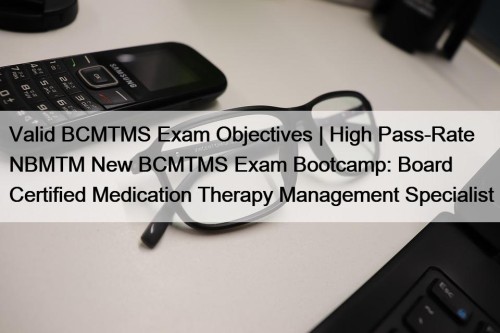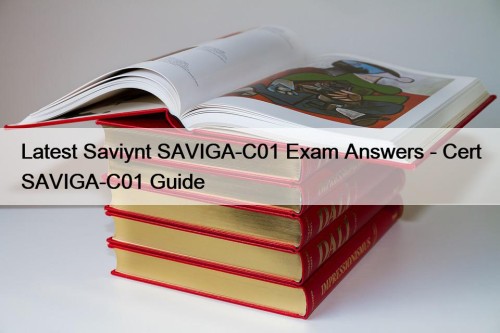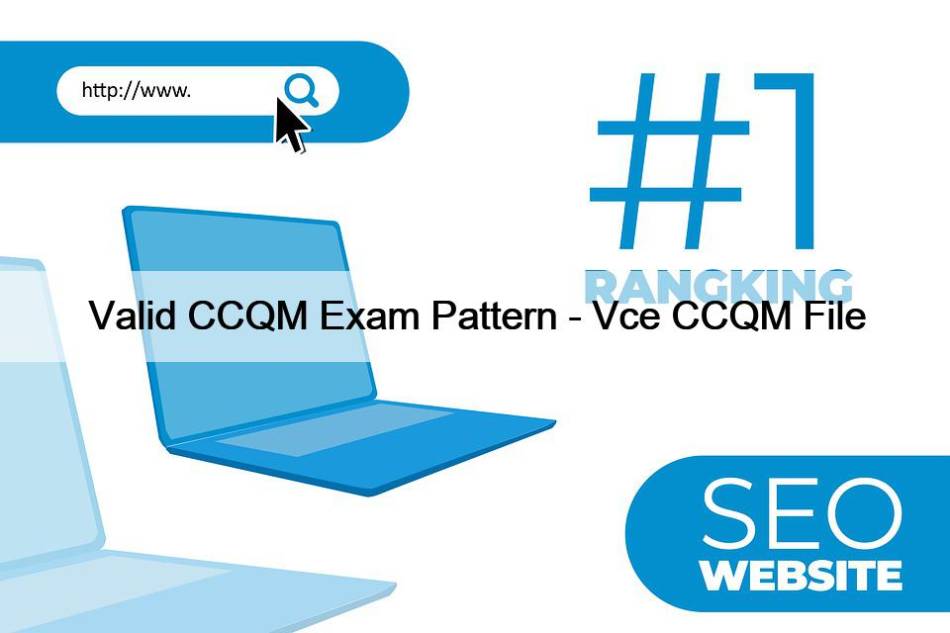Most Popular
 Valid BCMTMS Exam Objectives | High Pass-Rate NBMTM New BCMTMS Exam Bootcamp: Board Certified Medication Therapy Management Specialist
Valid BCMTMS Exam Objectives | High Pass-Rate NBMTM New BCMTMS Exam Bootcamp: Board Certified Medication Therapy Management Specialist
If you are the first time to take part in ...
 Latest Saviynt SAVIGA-C01 Exam Answers - Cert SAVIGA-C01 Guide
Latest Saviynt SAVIGA-C01 Exam Answers - Cert SAVIGA-C01 Guide
The pass rate is 98.75%, and we can ensure you ...
 2025 Salesforce Realistic Heroku-Architect Valid Test Tips Free PDF
2025 Salesforce Realistic Heroku-Architect Valid Test Tips Free PDF
2025 Latest Exams-boost Heroku-Architect PDF Dumps and Heroku-Architect Exam Engine ...



Valid CCQM Exam Pattern - Vce CCQM File

Our PDFDumps's CCQM exam training materials are mainly downloaded in PDF and software. We will regularly update, and will always provide the latest and the most accurate ASQ CCQM exam authentication information. With efforts for many years, the passing rate of our CCQM Exam has reached as high as 100%. If you have any concerns, you can try our CCQM pdf free demo and answers on probation first, and then make a decision whether to choose our CCQM dumps or not.
ASQ CCQM Exam Syllabus Topics:
| Topic | Details |
|---|---|
| Topic 1 |
|
| Topic 2 |
|
| Topic 3 |
|
| Topic 4 |
|
Highlighted Features of ASQ CCQM Exam Practice Questions
PDFDumps actual CCQM exam questions in PDF format are ideal for individuals who prefer to study on their tablets, laptops, and smartphones. Since these CCQM exam questions can be studied from any place at any time, making this format a perfect alternative for candidates who are frequently on the move and want to prepare for the exam in a short time. Questions in the ASQ CCQM Pdf Format are printable, allowing you to prepare for the CCQM test via hard copy. Our ASQ CCQM PDF version is regularly updated to improve the CCQM exam questions based on the CCQM real certification test’s content.
ASQ Certified Construction Quality Manager Sample Questions (Q15-Q20):
NEW QUESTION # 15
What should be included in the design of a strategy for conducting site quality audits in a dynamic construction environment?
- A. Prioritize audits of subcontractor activities while providing general oversight of other project areas.
- B. Focus audits on areas where previous problems were identified to verify that root causes have been resolved.
- C. Conduct audits randomly to catch teams unprepared and identify genuine issues.
- D. Plan regular, systematic audits and include mechanisms for immediate feedback and corrective actions.
Answer: D
Explanation:
A well-designed site quality audit strategy in a dynamic construction environment must ensure continuous monitoring, rapid feedback, and corrective actions to maintain compliance with project quality standards.
* Best Practices for Site Quality Audits:
* Regular & Systematic Audits: Planned site audits ensure continuous compliance rather than ad- hoc evaluations.
* Immediate Corrective Action Mechanisms: Issues identified during audits should be addressed promptly to avoid costly rework.
* Data-Driven Decision Making: Audits should capture quantitative and qualitative quality metrics.
* Steps in a Successful Quality Audit Process:
* Establish Clear Audit Objectives: Define scope, frequency, and criteria for assessments.
* Select Audit Team & Tools: Trained personnel must conduct inspections using standardized checklists.
* Report Findings & Take Action: Immediate resolution of non-compliance issues.
* Follow-Up Audits: Verify implementation of corrective actions.
* Why Other Options Are Incorrect:
* Option A (Random Audits to Catch Teams Unprepared): Randomized audits can create resistance and do not align with best practices for quality assurance.
* Option B (Focusing Only on Past Issues): While addressing past issues is important, audits must proactively assess all areas, not just known problems.
* Option D (Prioritizing Subcontractor Activities Only): While subcontractor quality is important, a comprehensive audit must cover all aspects of the project.
* Quality Management in Construction Projects (Site Quality Audit Strategy).
* QA Library (Audit Procedures in Construction).
ASQ Construction Quality Management (CQM) References:
NEW QUESTION # 16
When reviewing 'delegated' submittals, what should be the primary focus to ensure alignment with the project's quality plan and standards?
- A. Selecting the lowest cost options
- B. Verifying that submittals meet quality and performance standards
- C. Focusing more on aesthetics and design appeal than functionality
- D. Prioritizing options with the fastest delivery times
Answer: B
Explanation:
When reviewing delegated submittals, the primary focus should be ensuring compliance with the project's quality plan, specifications, and performance standards. Submittals are essential to verifying that all materials, products, and equipment incorporated into the project meet contractual requirements.
* Compliance with Contractual Requirements:
* All submittals must align with the contract specifications, Request for Proposal (RFP), and accepted contractor proposal.
* Design-Build projects require the Designer of Record (DOR) to approve submittals before a Government conformance review.
* Ensuring Quality & Performance Standards:
* The Quality Control (QC) Manager must review submittals to verify compliance with project quality plans.
* Performance-based submittals should demonstrate that proposed products meet functionality, durability, and safety requirements.
* Verification of Variations & Modifications:
* If a submittal proposes a deviation from contract requirements, it must undergo a formal review and approval process, including a Contracting Officer's decision.
* Variations require justification, including a technical analysis and potential cost impact.
* Integration with the Quality Plan & Three-Phase Control System:
* Submittals should be assessed as part of the Three-Phase Control System, ensuring thorough preparatory, initial, and follow-up reviews.
* Approved submittals should be available before starting any definable feature of work.
* A. Selecting the lowest cost options: Incorrect, as submittals should be evaluated based on quality and compliance, not cost alone.
* B. Prioritizing options with the fastest delivery times: Incorrect, because speed should not compromise compliance with technical specifications and performance requirements.
* D. Focusing more on aesthetics and design appeal than functionality: Incorrect, as safety, durability, and performance are more critical to construction quality management.
Key Aspects of Reviewing Delegated Submittals:Why Other Options Are Incorrect:Thus, Option C is the correct answer, ensuring all submittals are verified against quality and performance standards before approval.
NEW QUESTION # 17
Which of the following approaches would be best for creating a risk-based inspection and testing strategy for a high-rise structure in a seismic zone?
- A. Tailor the inspection strategy to follow best practices for seismic zone structural integrity
- B. Increase inspections only if there are signs of seismic activity during construction
- C. Balance the frequency of inspections with project timelines to minimize delays
- D. Adapt inspection strategies used in non-seismic zones with adjustments for seismic events
Answer: A
Explanation:
A risk-based inspection and testing strategy for a high-rise structure in a seismic zone must be designed specifically to account for the unique structural integrity challenges posed by seismic activity. A tailored approach ensures that construction quality management aligns with best practices in seismic resilience.
* Seismic Risk Assessment and Categorization
* The structure should be classified according to its seismic risk category based on national and international standards such as DOE-STD-1020-2016 and ANSI/ANS-2.26-2004 (R2010).
* Identifying structural components most vulnerable to seismic forces helps determine inspection priorities.
* Enhanced Inspection and Testing of Structural Components
* Special attention should be given to foundation stability, reinforced concrete elements, and load- bearing steel structures, ensuring they meet seismic design specifications.
* Use non-destructive testing (NDT) methods to assess material integrity and detect internal weaknesses.
* Structural Health Monitoring (SHM) Integration
* Implementing real-time monitoring systems, such as accelerometers and strain gauges, provides continuous data on the structure's response to seismic activity.
* Periodic structural health assessments should be conducted to evaluate fatigue and stress accumulation.
* Quality Assurance for Seismic-Resistant Materials and Design Features
* Material specifications should be aligned with seismic performance standards, ensuring high ductility and energy absorption capacity.
* Reinforced concrete and steel connections should undergo stringent inspection protocols.
* Compliance with Seismic Codes and Regulations
* Adherence to FEMA P-58, ASCE 7-16, and AISC 341-16 ensures that design and inspection practices are aligned with modern seismic engineering principles.
* Periodic audits should verify that construction phases comply with these regulatory standards.
* A. Adapt inspection strategies used in non-seismic zones with adjustments for seismic events - This does not fully address the unique risks of seismic activity. A tailored seismic approach is necessary.
* C. Balance the frequency of inspections with project timelines to minimize delays - While efficiency is important, inspections in seismic zones must be thorough and prioritized over project speed.
* D. Increase inspections only if there are signs of seismic activity during construction - A proactive, rather than reactive, approach is essential for ensuring structural resilience.
* DCS QA Document - Seismic Structural Integrity Guidelines.
* DOE-STD-1020-2016 - Natural Phenomena Hazards Analysis.
* ANSI/ANS-2.26-2004 - Categorization of Structures for Seismic Design.
Key Considerations for a Seismic-Optimized Inspection Strategy:Why Other Options Are Incorrect:
References:
NEW QUESTION # 18
What is a key benefit of outsourcing quality control processes to third-party services?
- A. Reducing the responsibilities of the internal quality team
- B. Streamlining processes by minimizing oversight from internal quality teams
- C. Gaining access to specialized expertise
- D. Reducing the need for internal training
Answer: C
Explanation:
Outsourcing quality control (QC) processes to third-party services provides construction companies with significant advantages, primarily by allowing access to specialized expertise. Third-party QC services typically employ highly trained professionals with extensive experience in quality management, testing, and compliance with industry regulations. This expertise can lead to improved accuracy in inspections, adherence to the latest industry standards, and better defect detection, ultimately enhancing construction quality.
Additionally, outsourcing can improve project efficiency and reduce overhead costs associated with maintaining an internal quality control team. Companies that outsource QC can focus more on core construction activities while ensuring that independent and unbiased quality checks are conducted. These third-party services also help meet regulatory and contractual quality requirements, mitigating the risk of project delays and costly rework.
* Quality Management in Construction Projects explains how external audits and third-party assessments enhance compliance and reduce defects.
* CQM Student Study Guide highlights the benefits of an effective QC system in reducing unnecessary costs and improving project outcomes.
* DOE & NAVFAC Standards emphasize independent quality assessments as part of ensuring high construction standards.
ASQ Construction Quality Management (CQM) References:Would you like more insights on specific third- party quality control certifications and compliance requirements?
NEW QUESTION # 19
The effectiveness of steps taken to achieve organizational goals based on implemented CoQ improvements should be evaluated by
- A. considering the initial cost reductions that are achieved
- B. analyzing both short-term results and long-term trends in quality and financial performance
- C. evaluating how many CoQ improvement projects are initiated
- D. focusing exclusively on short-term improvements to judge effectiveness
Answer: B
Explanation:
The effectiveness of steps taken to achieve organizational goals based on implemented Cost of Quality (CoQ) improvements should be evaluated by considering both short-term results and long-term trends. A comprehensive assessment provides a clearer picture of how quality initiatives impact financial performance and overall project success.
* Short-Term Results: These include immediate cost savings from reduced defects, rework, and material waste. Measuring these quick improvements helps justify initial investments in quality management.
* Long-Term Trends: Over time, sustained CoQ improvements lead to reduced failure costs, enhanced reputation, improved client satisfaction, and increased operational efficiency. Tracking long-term trends ensures that CoQ efforts remain effective and contribute to continuous improvement.
Organizations that focus solely on short-term improvements (Option A) may miss hidden costs and inefficiencies that only emerge over time. Initial cost reductions (Option B) may not reflect overall effectiveness if quality deteriorates later. The number of CoQ projects initiated (Option D) does not necessarily correlate with successful outcomes; effectiveness is better measured by performance data and financial impact.
* Quality Management in Construction Projects emphasizes that quality performance should be monitored through both short-term and long-term evaluations to ensure sustained cost benefits.
* QA Library discusses how failure costs (internal/external) and appraisal costs should be continuously analyzed to optimize quality investments.
* Cost of Quality (CoQ) principles suggest that measuring quality effectiveness requires tracking cost reductions, process efficiency, and defect rates over time.
ASQ Construction Quality Management (CQM) References:Would you like additional insights on quality cost tracking methods or benchmarking strategies?
NEW QUESTION # 20
......
Our CCQM study materials are designed by a reliable and reputable company and our company has rich experience in doing research about the study materials. We can make sure that all employees in our company have wide experience and advanced technologies in designing the CCQM Study Materials. So a growing number of the people have used our study materials in the past years, and it has been a generally acknowledged fact that the quality of the CCQM study materials from our company is best in the study materials market.
Vce CCQM File: https://www.pdfdumps.com/CCQM-valid-exam.html
- Quiz 2025 ASQ Accurate Valid CCQM Exam Pattern 📙 Easily obtain free download of 《 CCQM 》 by searching on “ www.torrentvce.com ” 🚏Training CCQM Material
- Quiz 2025 ASQ Accurate Valid CCQM Exam Pattern 💧 Easily obtain ▶ CCQM ◀ for free download through ✔ www.pdfvce.com ️✔️ 📬CCQM New Braindumps
- Certified Construction Quality Manager Exam Training Guide Improve Your Efficiency - www.examsreviews.com 👺 Copy URL ⇛ www.examsreviews.com ⇚ open and search for 《 CCQM 》 to download for free 🏺Latest CCQM Dumps Files
- CCQM Exam Braindumps 😝 CCQM Preparation 😏 CCQM Brain Dump Free 🛬 Search for ➡ CCQM ️⬅️ and easily obtain a free download on 「 www.pdfvce.com 」 😡Latest CCQM Dumps Files
- Certified Construction Quality Manager Exam Training Guide Improve Your Efficiency - www.real4dumps.com 🥟 Enter 「 www.real4dumps.com 」 and search for ⇛ CCQM ⇚ to download for free ⏰CCQM Certification Torrent
- Free PDF Quiz 2025 ASQ CCQM Authoritative Valid Exam Pattern 🐥 ➡ www.pdfvce.com ️⬅️ is best website to obtain ⏩ CCQM ⏪ for free download ⏏New CCQM Exam Bootcamp
- CCQM Latest Exam Dumps 🥜 CCQM New Dumps Sheet 🧤 New CCQM Exam Pattern 🙆 Open “ www.lead1pass.com ” and search for ▷ CCQM ◁ to download exam materials for free ➖CCQM Preparation
- ASQ CCQM Exam Questions - Updated Frequently 🌎 ▛ www.pdfvce.com ▟ is best website to obtain ➥ CCQM 🡄 for free download 🚥CCQM Brain Dump Free
- Effective Valid CCQM Exam Pattern | Easy To Study and Pass Exam at first attempt - Professional ASQ Certified Construction Quality Manager 🔯 Go to website ✔ www.real4dumps.com ️✔️ open and search for ▛ CCQM ▟ to download for free 🍎CCQM Latest Exam Dumps
- Quiz 2025 ASQ Accurate Valid CCQM Exam Pattern 🔰 Enter ▛ www.pdfvce.com ▟ and search for “ CCQM ” to download for free 😋CCQM Pdf Dumps
- ASQ CCQM Exam Questions - Get Excellent Scores 🚨 Download ➡ CCQM ️⬅️ for free by simply entering “ www.dumps4pdf.com ” website 🕝CCQM Exam Braindumps
- CCQM Exam Questions
- playground.turing.aws.carboncode.co.uk americasexplorer.onegodian.org www.jamieholroydguitar.com gurudaksh.com gyancool.com curso.adigitalmarketing.com.br eishkul.com courseguild.com www.ylabs-institute.org e-brainerx.com
Tags: Valid CCQM Exam Pattern, Vce CCQM File, Latest CCQM Exam Guide, CCQM Practical Information, Exam CCQM Bootcamp